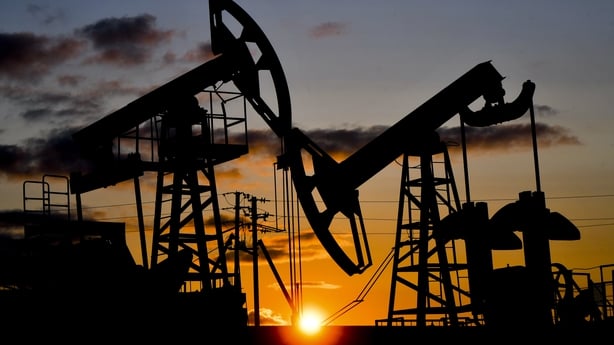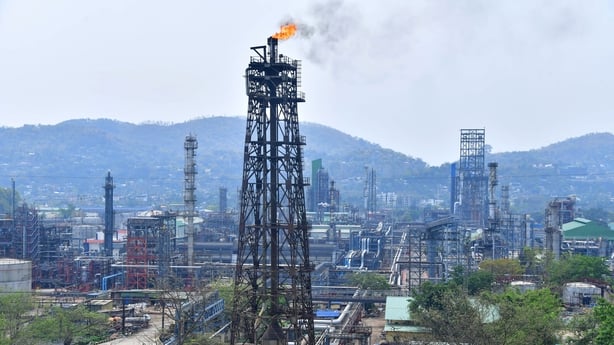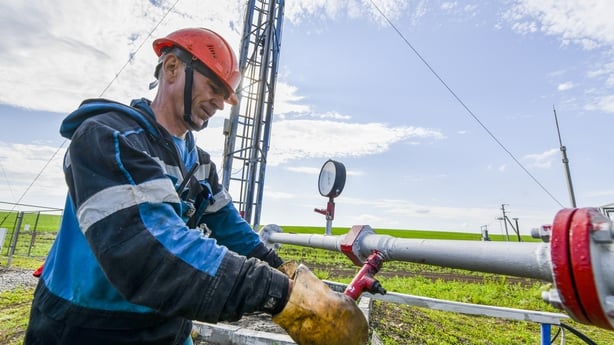This week, Hungary and Slovakia became involved in a diplomatic spat with Ukraine over Russian oil imports.
That is because, in June, Kyiv placed sanctions on Lukoil, Russia's largest oil company, in an effort to make a dent in the Kremlin's war economy.
Hungary buys about 70% of its oil supply from Russia and approximately half of that volume comes from Lukoil, via the Druzhba pipeline that traverses Ukraine.
With the country's supply of oil reduced, Hungarian officials have warned that their country could face a fuel shortage in the coming months.
Slovakia also buys about about 40% of its oil needs from Lukoil via the same route.
Hungary and Slovakia, which are often at odds with EU institutions over rule-of-law disputes and also oppose military aid for Ukraine, want the European Commission to put pressure on Kyiv to lift its restrictions so that Lukoil deliveries can resume.
Most European countries with access to ports cut their dependence on Russian oil imports during 2022 and 2023.
Hungary, Slovakia and the Czech Republic - all land-locked countries - were granted an exemption from EU sanctions on Russian oil until the end of this year.

But imports of Russian oil by Hungary and Slovakia pale in comparison to the volume purchased by bigger economies, particularly in Asia.
EU sanctions, introduced jointly with the G7 and Norway, banned imports of Russian crude oil in December 2022 and refined oil products from February 2023. They targeted Russian oil transported by sea, not via pipelines.
And they had a clear purpose: deprive the Kremlin of export revenues, just as Ukraine has tried to do in the case of Lukoil. The Kremlin taxes Russian energy companies heavily on export revenues - in some cases more than 40%.
In one sense, the EU and G7 sanctions have worked, at least in the west.
European countries (bar the three exceptions) have ditched Russia's black gold and found other sources to replace the commodity.
A study last February by the Centre for Research on Energy and Clean Air (CREA), a think tank headquartered in Helsinki, estimated that western sanctions had cost Russia's economy about 12% of its pre-war oil revenues, or the equivalent of €3.4bn per month.
But Russian companies quickly increased their exports to other big economies, offering cheaper priced oil and found companies from outside the sanctioning countries to ship its oil around the world. These vessels are often referred to as "shadow tankers" in the shipping industry.
The Kyiv School of Economics (KSE) estimated that Russia's oil revenues in 2023 reached $183 billion.
"There has been a re-shifting of global oil flows," Georg Zachmann, a senior energy expert at the Bruegel think tank in Brussels, told RTÉ News.

India, which has not condemned Russia's war on Ukraine, spent €65bn on Russian oil imports last year and now imports more than ten times the volume of the fuel from Russia compared to 2021.
Analysts say India bought up supplies of Russian oil at discounted prices after the introduction of sanctions when Russia had a lot of full oil tankers sitting around. Since then, India has since become the largest importer of seaborne Russian crude oil.
The surge in import levels from India has made up for much of the deficit left by European countries who ditched Russian crude.
However, China remains the number one importer overall, spending over €90bn on Russian oil imports last year. China imports about 60% via shipping vessels, with the remainder being delivered via the ESPO pipeline from Siberia.
Turkey and Brazil have also increased their imports since sanctions kicked in, €35bn and €11bn in 2023, respectively, though much of what the two countries buy is refined oil, as opposed to crude.
Malaysia and Singapore follow close behind.

Despite the west's sanctions, revenue levels for Russian crude and refined oil exports are now roughly the same today as they were in 2021, according to data compiled by CREA.
CREA uses data from Kpler, a tech company that provides real-time tracking data on shipping routes, to estimate seaborne exports of fossil fuels from Russia to other countries. Its researchers use national customs data to calculate volumes of Russia oil exported via pipeline.
Another big attempt by the EU and G7 to reduce Russian revenues from oil exports was to introduce, in December 2022, price caps on deliveries of oil to third countries. These set a cap of $60 per barrel on crude, and $100 per barrel on petroleum products such as fuel oil.
It means that shipping companies registered in the EU, G7, Norway and Australia can only transport Russian oil if it is sold at below $60 per barrel. Western governments avoided banning the transport of Russian oil altogether because that could have disrupted the global supply of oil and caused a spike in price.
However, many experts believe the caps have not worked, pointing out that there has been no real reduction in Russian oil exports nor a reduction in revenues for Russian oil companies.
"The oil price cap policy was set way higher than it should have been," Isaac Levi, a senior energy analyst at CREA, told RTÉ News.
"In Russia, the average cost of production is $15 per barrel but they are selling above the 60 dollar mark."

Prior to Russia's invasion of Ukraine, about 80% of Russian seaborne oil - both crude and refined - was shipped by either Western-owned or Western-insured shipping companies.
However, the opposite is now the case. Approximately 80% of Russian seaborne oil is now transported by the so-called "shadow fleet", companies that are registered or insured outside of EU or G7 countries.
Some vessels are insured by Russian insurers, but analysts have found it hard to identify how all vessels in the "shadow fleet" are insured.
The KSE estimates that just under 200 ships make up the fleet with Panama, Liberia and Gabon listed as the three most common flags under which the ships sail.
It is also difficult for customs authorities to confirm if transport companies, registered in third countries, are sticking to the price cap.
Exports of Russian oil by European-registered vessels have dwindled to a fraction of their pre-war level, whereas new shipping firms, registered in the United Arab Emirates, have cropped up since sanctions were introduced.
By late last year, UAE-registered tankers transported 40% of Russian crude, compared to only 11% in January 2022, one month before Russia's invasion of Ukraine, according to data from CREA.
"When one company is sanctioned, a new company pops up," said Mr Levi.







